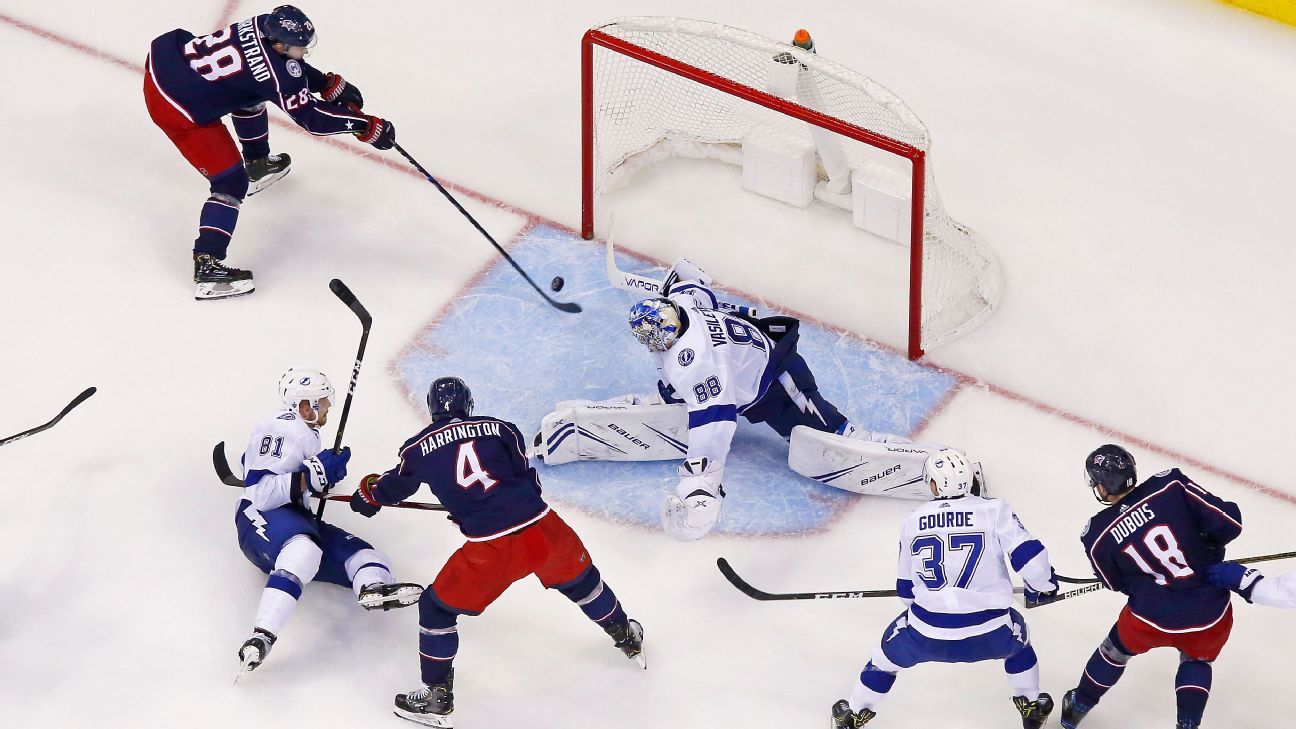COLUMBUS, Ohio — The Tampa Bay Lightning will be defined by their failure, swept out of the 2019 Stanley Cup playoffs in the first round by a Columbus Blue Jackets team few thought had a prayer of hanging with the Presidents’ Trophy winners.
That’s one way to look at them.
Here’s the spin the Lightning had after Tuesday night’s stunning 7-3 defeat in Game 4 of the first round: They were victims of their own success.
The Lightning had 128 points in the regular season, with a points percentage of .780, the second-highest rate for an 82-game season in NHL history, behind only the 1995-96 Detroit Red Wings (.799). They tied that Red Wings team with 62 wins, the most recorded in the 100-plus-year history of NHL hockey. They clinched a playoff spot after just 68 games and were coasting well before reaching that mark. They weren’t just winning — they were crushing opponents. They had the league’s best power play and best penalty kill, and they were the highest-scoring team on average (3.89) since Detroit in that 1995-96 season. Of their 62 wins, 30 were by a margin of three or more goals, which was tied for the most since 1992-93.
It all came so easily for Tampa Bay — until it didn’t.
“When you have the amount of points we had, it’s a blessing and a curse, in a way. You don’t play any meaningful hockey for a long time. Then all of a sudden, you have to ramp it up. It’s not an excuse. It’s reality,” Lightning coach Jon Cooper said after Game 4. “That’s how it goes: You have a historic regular season, and we had a historic playoff.”
Indeed, the Lightning made history in the 2019 playoffs — just not the kind any coach would want. For the first time in league history, a team with the most points in the regular season failed to win a game in an opening-round, seven-game series.
“If we had the answers, we would have found a way to win a game. It sucks,” captain Steven Stamkos said.
There are some obvious factors behind the Lightning’s stunning demise:
-
The Blue Jackets put on a defensive clinic in the series, playing a 1-2-2 forecheck the slowed the pace, owned the neutral zone and never allowed the Lightning to find their way offensively. The Jackets had 30 takeaways in four games, while Tampa Bay had 21. “Columbus is pretty good at shutting it down. They never did that in the regular season because they were always chasing us,” Cooper said. “The last time we played here, we had a 5-1 lead, and they had completely outplayed us. We just scored every time we went down the ice.”
-
Blue Jackets goalie Sergei Bobrovsky had the best postseason of his career, with a .932 save percentage and a 2.01 goals-against average. Even when the Lightning broke through the Columbus defense, Bobrovsky made key saves. In contrast, Tampa Bay goalie Andrei Vasilevskiy finished the series with an .856 save percentage and a 3.82 goals-against average.
-
Perhaps the biggest disparity was on special teams. The Lightning had the most effective power play since 1988-89 in the regular season, at 28.1 percent. They were playing a team, however, that was short-handed the fewest times in the regular season. The Lightning scored once on just six power-play opportunities in this series; the Blue Jackets, meanwhile, were a stellar 5-for-10 with the man advantage. “No power plays. One PP in two games. It’s tough. I don’t know what to say,” said Nikita Kucherov, the Lightning’s star winger who won the NHL scoring title this season.
Kucherov was suspended for Game 3 of the series for an illegal check in Game 2. Star defenseman Victor Hedman played hurt in Games 1 and 2 and missed the final two games of the series.
Asked if this Lightning core can still capture a Stanley Cup at full strength, Stamkos said, “Yeah, we believe in it. But it’s one thing to say it, and it’s another to execute. They executed a detailed game plan to slow us down, and we didn’t have a response to it. You have to give them some credit. Everyone’s going to talk about us losing the series, but they did a lot of good things. We just didn’t have an answer.”
This core was together when the Lightning lost in the 2016 conference finals, losing Games 6 and 7 to the Pittsburgh Penguins. It was together when they lost Games 6 and 7 (again) to the Washington Capitals last season. Against the Blue Jackets, they squandered a 3-0 lead in Game 1 and never recovered after the Jackets rallied to win.
“I don’t know,” Cooper said when asked if there’s a fundamental flaw in how the team handles adversity. “It’s funny: We’re expected to go far this year, and we go nowhere. In 2015, no one expected us to go anywhere, and we went far, with the same core of players.
“It’s hard to win in this league. It’s tough not to be holding up the Stanley Cup at the end, but how many teams have gone through this? They knock at the door and knock at the door and then … you look at Washington, for example. They had two remarkable years and got bounced in the second round, and the year no one expected them to do anything, they won the Stanley Cup.”
From Oct. 6, 2018, through April 6, 2019, the Lightning were the favorites to win the Stanley Cup and one of the most dominant regular-season teams in the history of the league.
Then the playoffs started.
“We couldn’t find our game. It’s that clear. For six days in April, we couldn’t find it,” Cooper said. “It’s unfortunate because it puts a blemish on what was one helluva regular season.”
Added Stamkos: “If you don’t accomplish the goal of winning it all, it’s a failure. We don’t care about what happened in the regular season.”

